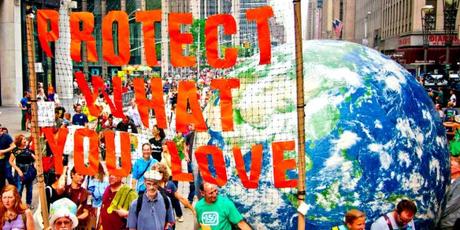GR: When I introduced David Wallace-Wells’ story last week, I mentioned that some prominent climate scientists criticized the article because of its warning of disaster and doom. Those scientists believe that gentle persuasion instead of an emergency declaration is the correct way to deliver the climate-emergency message. They are afraid people would be so overwhelmed by the truth, they might simply give up.

By 2100, the coolest months in tropical South America, Africa, and the Pacific are likely to be warmer than the warmest months at the end of the 20th century. Photo: Heartless Machine
There are other reasons that scientists soften their warnings. Gentle persuasion is resistant to the most intense forms of ridicule by oil-company sponsored climate-change deniers (whew). And gentle persuasion isn’t criticized by other scientists (who learned at their mentors’ knee true science is never certain). However, I disagreed with the arguments for gentle persuasion because there hasn’t been enough climate-change action and almost no one is behaving as if they understand that we are in the midst of a global emergency.
I want to mention one of the best explainers of global climate change, Dr. Paul Beckwith. Dr. Beckwith posts informative videos on YouTube. Beckwith is a moderate climate scientist who believes the climate-change emergency is real. He has been very upset by the scientists’ attack on the Wallace-Wells story and has posted several videos discussing the attacks. Here’s the link to one of his videos if you want to sample the flavor of his response.
The article below by Margaret Klein Salamon, a clinical psychologist, explains why scientists need to drop the sugar-coating and let people worry if they will, for worry is often a necessary precursor to action. And we need action. Let me assure you that we are in a global climate emergency.

“The article has caused a major controversy in the climate community, in part because of some factual errors in the piece—though by and large the piece is an accurate portrayal of worst-case climate catastrophe scenarios. But by far the most significant criticism the piece received was that it was too frightening.
“Importantly, fear does not motivate, and appealing to it is often counter-productive as it tends to distance people from the problem, leading them to disengage, doubt and even dismiss it,” wrote Michael Mann, Susan Joy Hassol and Tom Toles at the Washington Post.
“Erich Holthaus tweeted about the consequences of the piece:
- “A widely-read piece like this that is not suitably grounded in fact may provoke unnecessary panic and anxiety among readers.”
- “And that has real-world consequences. My twitter feed has been filled w people who, after reading DWW’s piece, have felt deep anxiety.”
- “There are people who say they are now considering not having kids, partly because of this. People are losing sleep, reevaluating their lives.”
“While I think both Mann and Holthaus are brilliant scientists who identified some factual problems in the article, I strongly disagree with their statements about the role of emotions—namely, fear—in climate communications and politics. I am also skeptical of whether climate scientists should be treated as national arbiters of psychological or political questions, in general. I would like to offer my thoughts as a clinical psychologist, and as the founder and director of The Climate Mobilization.” –Margaret Klein Salamon (Please continue reading: Why Being Fearful Can Spark Climate Action.)

